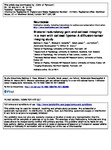Bilateral redundancy gain and callosal integrity in a man with callosal lipoma: a diffusion-tensor imaging study
| dc.contributor.author | Roser, ME | |
| dc.contributor.author | Corballis, MC | |
| dc.contributor.author | Jansari, A | |
| dc.contributor.author | Fulford, J | |
| dc.contributor.author | Benattayallah, A | |
| dc.contributor.author | Adams, WM | |
| dc.date.accessioned | 2019-07-12T14:38:44Z | |
| dc.date.available | 2019-07-12T14:38:44Z | |
| dc.date.issued | 2011-07-26 | |
| dc.identifier.issn | 1465-3656 | |
| dc.identifier.issn | 1465-3656 | |
| dc.identifier.uri | http://hdl.handle.net/10026.1/14637 | |
| dc.description.abstract |
We investigated whether abnormalities in the structural organization of the corpus callosum in the presence of curvilinear lipoma are associated with increased facilitation of response time to bilateral stimuli, an effect known as the redundancy gain (RG). A patient (A.J.) with a curvilinear lipoma of the corpus callosum, his genetically-identical twin, and age-matched control participants made speeded responses to luminant stimuli. Structural organization of callosal regions was assessed with diffusion-tensor imaging. A.J. was found to have reduced structural integrity in the splenium of the corpus callosum and produced a large RG suggestive of neural summation. | |
| dc.format.extent | 185-198 | |
| dc.format.medium | Print-Electronic | |
| dc.language | en | |
| dc.language.iso | en | |
| dc.publisher | Informa UK Limited | |
| dc.subject | Corpus callosum | |
| dc.subject | Redundancy gain | |
| dc.subject | Diffusion-tensor imaging | |
| dc.title | Bilateral redundancy gain and callosal integrity in a man with callosal lipoma: a diffusion-tensor imaging study | |
| dc.type | journal-article | |
| dc.type | Article | |
| plymouth.author-url | https://www.webofscience.com/api/gateway?GWVersion=2&SrcApp=PARTNER_APP&SrcAuth=LinksAMR&KeyUT=WOS:000303565400002&DestLinkType=FullRecord&DestApp=ALL_WOS&UsrCustomerID=11bb513d99f797142bcfeffcc58ea008 | |
| plymouth.issue | 3 | |
| plymouth.volume | 18 | |
| plymouth.publisher-url | http://www.tandfonline.com/doi/abs/10.1080/13554794.2011.568505 | |
| plymouth.publication-status | Published | |
| plymouth.journal | Neurocase | |
| dc.identifier.doi | 10.1080/13554794.2011.568505 | |
| plymouth.organisational-group | /Plymouth | |
| plymouth.organisational-group | /Plymouth/Faculty of Health | |
| plymouth.organisational-group | /Plymouth/REF 2021 Researchers by UoA | |
| plymouth.organisational-group | /Plymouth/REF 2021 Researchers by UoA/UoA04 Psychology, Psychiatry and Neuroscience | |
| plymouth.organisational-group | /Plymouth/Research Groups | |
| plymouth.organisational-group | /Plymouth/Research Groups/Centre for Brain, Cognition and Behaviour (CBCB) | |
| plymouth.organisational-group | /Plymouth/Research Groups/Centre for Brain, Cognition and Behaviour (CBCB)/Brain | |
| plymouth.organisational-group | /Plymouth/Users by role | |
| plymouth.organisational-group | /Plymouth/Users by role/Academics | |
| dc.publisher.place | England | |
| dc.identifier.eissn | 1465-3656 | |
| dc.rights.embargoperiod | Not known | |
| rioxxterms.versionofrecord | 10.1080/13554794.2011.568505 | |
| rioxxterms.licenseref.uri | http://www.rioxx.net/licenses/all-rights-reserved | |
| rioxxterms.type | Journal Article/Review |


